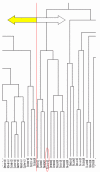Interactions between SNP alleles at multiple loci contribute to skin color differences between caucasoid and mongoloid subjects
- PMID: 18392143
- PMCID: PMC2288787
- DOI: 10.7150/ijbs.4.81
Interactions between SNP alleles at multiple loci contribute to skin color differences between caucasoid and mongoloid subjects
Abstract
This study aimed to identify single nucleotide polymorphism (SNP) alleles at multiple loci associated with racial differences in skin color using SNP genotyping. A total of 122 Caucasians in Toledo, Ohio and 100 Mongoloids in Japan were genotyped for 20 SNPs in 7 candidate genes, encoding the Agouti signaling protein (ASIP), tyrosinase-related protein 1 (TYRP1), tyrosinase (TYR), melanocortin 1 receptor (MC1R), oculocutaneous albinism II (OCA2), microphthalmia-associated transcription factor (MITF), and myosin VA (MYO5A). Data were used to analyze associations between the 20 SNP alleles using linkage disequilibrium (LD). Combinations of SNP alleles were jointly tested under LD for associations with racial groups by performing a chi(2) test for independence. Results showed that SNP alleles at multiple loci can be considered the haplotype that contributes to significant differences between the two population groups and suggest a high probability of LD. Confirmation of these findings requires further study with other ethnic groups to analyze the associations between SNP alleles at multiple loci and skin color variation among races.
Keywords: Haplotype; Linkage disequilibrium; Polygene; SNP.
Conflict of interest statement
Conflict of Interests: The authors have declared that they have no conflict of interest.
Figures


References
-
- Rouzaud F, Kadekaro AL, Abdel-Malek ZA et al. MC1R and the response of melanocytes to ultraviolet radiation. Mutat Res. 2005;571:133–152. - PubMed
-
- Jablonski NG, Chaplin G. The evolution of human skin coloration. J Hum Evol. 2000;39:57–106. - PubMed
-
- Myles S, Somel M, Tang K. et al. Identifying genes underlying skin pigmentation differences among human populations. Hum Genet. 2007;120:613–621. - PubMed
-
- Izagirre N, Garcia I, Junquera C et al. A scan for signatures of positive selection in candidate loci for skin pigmentation in humans. Mol Biol Evol. 2006;23(9):1697–1706. - PubMed
Publication types
MeSH terms
Substances
LinkOut - more resources
Full Text Sources
Research Materials

